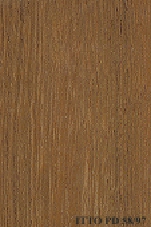
ULIN (Eusideroxylon zwageri)
Trade Name
Ulin
Scientific Name
Eusideroxylon zwageri Teijsmann & Binnendijk
Family
Lauraceae
Common Names
Yam muk; Terbelian; Telian; Tebelian; Tanoedlen; Tadien; Sakian; Oelin; Melangganai; Lampahoeng; Ku`an tin; Kayu besi; Kajoe besi; Kajo taha; Im muk; Ijzerhout; Caju baelian; Borneosch ijerhout; Boelian; Belian wi; Belian tembaga; Belian kapur; Belian griting; Belian buloh; Belian bulch; Balian; Belian (Indonesia); Tabulin (Indonesia); Tihin (Indonesia); Onglen (Indonesia); Bajujang (Indonesia); Ulin (Indonesia); Belian (Sarawak); Onglen ulin (Indonesia); Billian (Indonesia); Tambusian (Sabah); Tambulian (Philippines); Borneo ironwood (United Kingdom); Legno ferro di borneo (Italy)
Description Of The Tree
Botanical Description
It is an evergreen tree of up to 40 m tall. The bole is straight, branchless for up to 20 m but usually less, sometimes slightly fluted at the base, up to 150 cm in diameter. The buttresses are many, small and rounded, giving the base an elephant-foot lik
Natural Habitat
Generally a species of lowland primary forest. Belian or ironwood is one of the most renowned timbers of Borneo. Indonesia has banned the export of belian and Sarawak has placed restrictions on export; Sabah and Kalimantan continue to export it. Regenerat
Natural Distribution
It can be found throughout the lowlands of Sabah extending into the remainder of Borneo, other Indonesian islands, and the Philippines; occasionally abundant.
Wood Identification
Anatomic Description Of Wood
Wood diffuse porous. Vessels exclusively solitary (over 90%). Tangential diameter of vessel lumina 100 micras or less (very small). Vessels per mm2 more than 20 (very abundant). Intervessel pits scalariform. Vessel-ray pits reticulate and/or foraminate. Multipl Apotracheal axial parenchyma diffuse and/or diffuse in aggregates. 5 to 8 cells per parenchyma strand. 4 to 10 rays per mm (medium). Prismatic crystals in radial alignment in procumbent ray cells (chambered cells). Prismatic crystals in the ray cells. Body ray cells procumbent with mostly 2 to 4 rows of upright and/or square marginal cells (Kribs-II). Body ray Fibers with distinctly bordered pits.
-
 Wood Macro Photo Tangential Plane
Wood Macro Photo Tangential Plane
Availability
Cites Status
Unrestricted
General Wood Description
Odor
Its odor resembles lemons.
Color
The sapwood is pale yellowish. The heartwood varies from yellow-brown to reddish yellow-brown, becoming dark brown or almost black on exposure.
COLOR INDEX (1=Black, 7=Light yellow,white)
3
Grain
It is straight, only occasionally interlocked.
Texture
The texture is from fine to medium.
Luster
The heartwood is somewhat lustrous.
Natural Durability
It is very durable and very resistant to teredos and termites attack.
Natural durability index (1= Very high durability, 7=Vey low durability)
1
Silica Content
Silica Content: It is reported to contain up to 0.5% silica. Silica Value: 0.5
Resistance To Impregnation
The heartwood is extremely resistant to preservative treatment.
Wood Physical Properties
Basic Density or Specific Gravity (O.D. weight/vol. green) (g/cm³)
0.88
Air-dry Density (Weight and volume at 12%MC) (g/cm³)
1.02
Total shrinkage Tangential (Saturated to 0%MC) (%)
7.7
Total shrinkage Radial (Saturated to 0%MC) (%)
4.3
Drying Defects
Ease of Drying: Air seasoning is reported to be easy. Drying Defects: Little warping and checking are reported. Kiln Schedules: Schedule suggested for Thitmin.
Recommended Dry Kiln Schedule
UK-B; US-T2-C2
Dimensional stability ratio (Total Tangential Shrinkage %/Total Radial Shrinkage %)
1.8
Wood Chemical Properties
Wood Mechanical Properties
Bending Strength (MOR),12%MC (kgf/cm²)
1648
Stiffness (MOE) 12%MC (kgf/cm²)
185212
Compression parallel to fiber 12%MC (kgf/cm²)
819
Shear strength radial 12%MC (kgf/cm²)
129
Janka hardness (side) 12%MC (kgf)
1276
Janka hardness (end grain) 12%MC (kgf)
1094
Workability
Sawing
Sawmilling of this species is reportedly easy to fair.
Rotary Veneer Cutting
Good veneer can be made, but it is too dense and insufficiently ornamental for this purpose.
Sliced Veneer
Good veneer can be made, but it is too dense and insufficiently ornamental for this purpose.
Blunting Effect
It blunts saw-teeth fairly rapidly, owing to its hardness. The teeth should be cleaned regularly from oily deposits.
Machining
Special cutters are required.
Planing
Planing of this species is reported to it gives good results despite its hardness.
Boring
Too high boring speeds may cause burning of the surface.
Mortising
It is easy to mortise.
Nailing
Pre-boring is essential.
Gluing
The timber is reported to require special precautions for gluing.
Sanding
This species is reported to be easy to sand.
REFERENCED USES
End Uses Summary
EXTERIOR GENERAL, bridges, stakes posts, crossties, HOUSING GENERAL, flooring, PLYWOOD AND VENEER, TOOLS, CONTAINERS, truck bodies, NAVAL CONSTRUCTION, port pillar, OTHER AND MUSICAL INSTRUMENTS, shingle
Exterior General
- 1 - Tabela de resultados de ensaios fisicos e mecanicos
Bridges
- 2 - 25 madeiras da amazonia de valor comercial, caracterizacao, macroscopica, usos comuns e indices qualificativos
Stake Posts
- 5 - Propriedades fisicas e mecanicas da madeira e do contraplacado de Pinus elliottii
Crossties
- 8 - Maderas latinoamericas. III, Podocarpus standleyi ,Podocarpus oleifolius, Drims granadensis, Magnolia poasana y Didymopanax pittieri
General Housing
- 10 - Silica in Timbers
Flooring
- 14 - Handbook of Hardwoods
Panels, Veneers
- 25 - Directory of Timber Trade Malaysia
Tools
- 42 - Utilización Industrial de Nuevas Especies Forestales en el Perú.
Truck Body
- 53 - Timbers of the New World
Shipbuilding
- 55 - Tropical Timber Atlas of Latin America
Port Pillar
- 61 - Manual de Diseño para Maderas del Grupo Andino
Shingles
- 77 - Amazonian Timbers, Characteristics and Utilization Volume I; Tapajós National Forest
Please Provide Information To View Producer Information